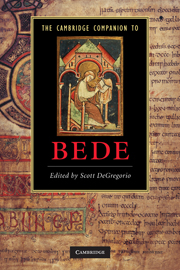7 - Bede and education
from Part II - Bede's Writings
Published online by Cambridge University Press: 28 January 2011
Summary
The Venerable Bede occupies a pivotal place and moment in the history of Western education. By the seventh century public schools no longer existed in Europe; only scattered remnants of the liberal aristocratic educational system of the Roman empire remained in northern Italy and Spain, none at all in Gaul and Britain. Bede's lifetime coincides with the revival of education and the beginnings of a new medieval Christian culture in the West. Bede's monastery of Wearmouth-Jarrow is the nodal point and Bede the intellectual force that link the civilization of the ancient world with the Carolingian renaissance, which fuelled in its turn the renaissances of the twelfth and the fifteenth and sixteenth centuries. In Britain, the old educational system had disappeared without leaving a trace. Missionaries from the continent and from Ireland, beginning with the Gregorian mission under Augustine in 597, carried out their work of conversion most effectively through the establishment of monasteries. Monks had to be trained for their vocation; monastic schools followed inevitably. Irish models of scholarship and monastic education exerted their influence throughout the seventh century. There was no formal division of the curriculum into subjects along the lines of the seven liberal arts of late classical antiquity. Pupils learned what they needed to know by a kind of apprenticeship system.
- Type
- Chapter
- Information
- The Cambridge Companion to Bede , pp. 99 - 112Publisher: Cambridge University PressPrint publication year: 2010
- 3
- Cited by



